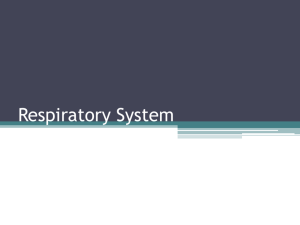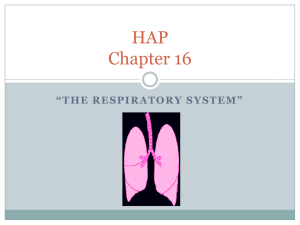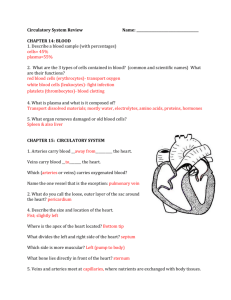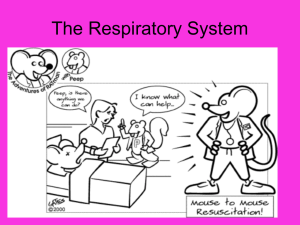The Respiratory System
advertisement
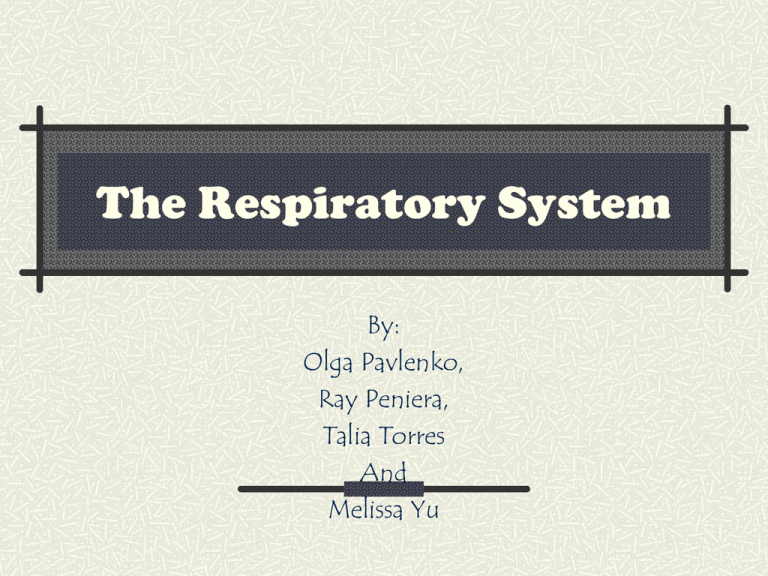
The Respiratory System By: Olga Pavlenko, Ray Peniera, Talia Torres And Melissa Yu What is the respiratory system? Respiration, or gas exchange is the uptake of molecular oxygen from the environment and the discharge of carbon dioxide to the environment. Respiratory Surface The respiratory surface is the part of the animal’s body where gases are exchanged with the surrounding environment. Animals do not move oxygen and carbon dioxide across membranes by active transport so movement of these gases between respiratory surface and the environment occurs by diffusion. Respiratory Medium The respiratory medium is the source of oxygen for terrestrial animals. Respiratory medium (air of water) O2 CO2 Respiratory surface Organismal level Circulatory system Cellular level Energy-rich molecules from food Figure 42.19 Cellular respiration ATP The Parts of The Respiratory System Nasal Cavity The air passage behind the nose that plays an important role in breathing The human inhales oxygen and exhales carbon dioxide through the nasal cavity Pharynx An area in the vertebrate throat where air and food passages cross. It extends from the mouth and nasal cavities to the larynx, where it continues to the esophagus. Larynx The voice box containing the vocal cords. It is located between the pharynx and the trachea. Trachea A thin-walled, cartilaginous tube passing from the larynx to the bronchi that carries air to the lungs. It is also known as the windpipe. Bronchi The two branches of breathing tubes that branch from the trachea that lead to the lungs. At the end of each bronchus is a bronchiole, which is one of the fine branches that transport air to the alveoli. Diaphragm The main breathing muscle, that contracts when inhaling, and releases when exhaling. A sheet of skeleton muscle that forms the bottom wall of the chest cavity. Lungs Two, spongy, saclike respiratory organs in most vertebrates, occupying the chest cavity together with the heart and functioning to remove carbon dioxide from the blood and provide it with oxygen. Carbon Dioxide Transport in Blood 1. Carbon dioxide produced by body tissues diffuses into the interstitial fluid and the plasma. 2 .Over 90% of CO2 diffuses into the red blood cells, which leaves 7% in the plasma as dissolves CO2. 3. Some CO2 is picked up and transported by hemoglobin. 4. However, most CO2 reacts with water in red blood cells, forming carbonic acid (H2CO3), a reaction catalyzed by carbonic anhydrase contained within red blood cells. 5. Carbonic acid dissociates into a biocarbonate ion (HCO3–) and a hydrogen ion (H+). 6. Hemoglobin binds most of the \H+ from H2CO3 preventing the H+ from acidifying the blood and thus preventing the Bohr shift. Carbon Dioxide Transport in Blood (continued) 7. Most of the HCO3– diffuse into the plasma where it is carried in the bloodstream to the lungs. 8. In the HCO3– diffuse from the plasma red blood cells, combining with H+ released from hemoglobin and forming H2CO3. 9. Carbonic acid is converted back into CO2 and water. 10. CO2 formed from H2CO3 is unloaded from hemoglobin and diffuses into the interstitial fluid. 11. CO2 diffuses into the alveolar space, from which it is expelled during exhalation. The reduction of CO2 concentration in the plasma drives the breakdown of H2CO3 Into CO2 and water in the red blood cells (see step 9), a reversal of the reaction that occurs in the tissues (see step 4). Carbon Dioxide Transport Control of Breathing in Humans The main breathing control centers are located in regions of the brain, the medulla, and the pons. Aided by the control center in the pons, the medulla center sets the basic breathing rhythm. Secondary control over breathing is exerted by sensors in aorta and carotid arteries that monitor O2 and CO2 concentrations in the blood as well as pH. During deep breathing, a negative feedback mechanism prevents the lungs from over expanding; stretch sensors in the lung tissue send nerve impulses that inhibit the medulla’s control center. Control of Breathing in Humans (Cont.) The medulla’s control center regulates breathing activity in response to changes in pH of the tissue fluid (cerebrospinal fluid) bathing the brain. When the O2 level is severely depressed O2 sensors in the aorta and carotid arteries in the neck send alarm signals to the breathing control centers, which respond by increasing breathing rate. Normally a rise in CO2 concentration is a good indication of a fall in O2 concentration because CO2 is produced by the same process that consumes O2-cellular respiration The breathing center responds to a variety of nervous and chemical signals and adjusts breathing rate and depth to meet changing demands. The Role of Partial Pressure Gradients Gases diffuse down pressure gradients in the lungs and other organs. Diffusion of a gas, whether present in air or dissolved in water, depends on differences in a quantity called partial pressure. A gas always diffuses from a region of higher partial pressure to a region of lower partial pressure. How the pressure gradient is maintained 1. 2. 3. 4. Blood arriving at the lungs via the pulmonary arteries has a lower PO2 and a higher PCO2 than the air in the alveoli. As blood enters the alveolar capillaries, CO2 diffuses from the blood to the air in the alveoli. Meanwhile O2 in the air dissolves in the fluid that coats the epithelium and diffuses into the blood. When the blood leaves the lungs in the pulmonary veins, its PO2 has been raised and its PO2 has been lowered. After returning to the heart, this blood is pumped through the systemic circuit. In the tissue capillaries, gradient of partial pressure favor the diffusion of O2 out of the blood and CO2 into the blood. This is because cellular respiration removes O2 from and adds CO2 to the interstitial fluid. After the blood unloads O2 and loads CO2, it is returned to the heart and pumped to the lungs again, where it exchanges gases with air in the alveoli. Inhaled air Exhaled air 160 0.2 O2 CO2 120 27 Alveolar spaces O2 CO2 104 Alveolar epithelial cells 40 O2 CO2 Blood entering alveolar capillaries 40 O2 CO2 O2 Alveolar capillaries of lung 45 O2 CO2 104 40 O2 CO2 Pulmonary veins Pulmonary arteries Systemic arteries Systemic veins Heart CO2 Tissue capillaries O2 Blood entering tissue capillaries Blood leaving tissue capillaries 40 Blood leaving alveolar capillaries 45 O2 CO2 100 40 O2 CO2 O2 CO2 Tissue cells <40 >45 O2 CO2 Respiratory pigments A protein that transports oxygen in blood. The pigments increase amount of oxygen that can be carried in blood. Oxygen transport A diversity of respiratory pigments have evolved in different kinds of animal taxa. A type of respiratory pigment that uses copper as its oxygenbinding component is called hemocyanin, which is found in the hemolymph of arthropods and molluscs. Hemoglobin consists of 4 subunits, each with a cofactor called heme group consisting of an iron atom at its center. Each hemoglobin molecule can carry molecules of O2. They must bind O2 reversibly, loading O2 in the lungs, and unloading it in other parts of the body. This process depends on cooperatively between subunits of hemoglobin molecule. Oxygen Transport (cont.) Binding of O2 to a subunit induces the others to change shape slightly, with the result that there affinity for O2 increases. When one subunit unloads its O2, the other three quickly unload, too as a shape change lowers their affinity for O2. Bibliography http://library.thinkquest.org/5777/resp2.htm http://library.thinkquest.org/2935/Natures_Best/Nat_Best_High_Level/Re spiratory_Net_Pages/Respiratory_title.html http://users.rcn.com/jkimball.ma.ultranet/BiologyPages/P/Pulmonary.ht ml http://www.emc.maricopa.edu/faculty/farabee/BIOBK/BioBookRESPSYS.ht ml http://www.getbodysmart.com/ap/respiratorysystem/menu/menu.html http://www.nhlbi.nih.gov/health/dci/Diseases/hlw/hlw_respsys.html http://www.cdli.ca/~dpower/resp/main.htm http://www.webmd.com/lung/how-we-breathe http://www.biotopics.co.uk/humans/resyst.html http://www.ivyrose.co.uk/HumanBody/Respiratory/Respiratory_System.php Activities (1) Name the Function of each of the following: Nasal Cavity: _______________________ Pharynx:____________________________ Larynx: ____________________________ Trachea (Windpipe): __________________ Lungs: _____________________________ Bronchi: ___________________________ Bronchioles: ________________________ Diaphragm: _________________________ (2) Identify the following parts: (3) Match the Term with its Definition _____. Respiratory medium _____. Nasal Cavity _____. Pharynx _____. Larynx _____. Trachea _____. Bronchi _____. Bronchioles _____. Diaphragm _____. Lungs _____. Breathing Control Centers _____. Partial Pressure Gradients _____. Respiratory Pigment a. Area in vertebrate throat that extends from the mouth and nasal cavities to the larynx, where it continues to the esophagus. b. Voice box containing vocal chords between the pharynx and trachea c. A protein that transports oxygen in blood. d. Branch at ends of Bronchi. e. Air passage behind the nose. f. Source of oxygen for terrestrial animals. g. Two, spongy, saclike respiratory organs in most vertebrates, occupying the chest cavity together with the heart. h. Located in regions of the brain, the medulla, and the pons. i. A sheet of skeleton muscle that forms the bottom wall of the chest cavity. j. Diffuse gas in the lungs and other organs. k. The two branches of breathing tubes that branch from the trachea that lead to the lungs. l. A thin-walled, cartilaginous tube passing from the larynx to the bronchi, also known as the windpipe. Answers to the Activities Activity (1) The nasal cavity conditions the air to be received by the other areas of the respiratory tract. The air passing through the nasal cavity is warmed or cooled within 1 degree of body temperature. The part before the trachea that air passes through. It is important in vocalization. Sound is made in larynx, and that is where pitch and volume are controlled. The strength of expiration from the lungs also contributes to loudness. A thin-walled, cartilaginous tube that carries air from the larynx to the lungs and bronchi. Spongy, saclike respiratory organs that remove carbon dioxide from the blood, and replaces it with oxygen. The subdivisions of the trachea that convey air to and from the lungs. Small terminal branches of the bronchi in the lungs. It lacks cartilage, and is lined with smooth muscle, which controls the lumen size. When breathing, the diaphragm contracts and flattens down, thus increasing the capacity of the chest, and causing air to be drawn into the lungs. Activity (2) 1. 2. 3. 4. 5. 6. 7. 8. 9. Nasal cavity Oral cavity Pharynx Larynx Trachea Bronchi Lung Heart Ribs Activity (3) f. e. a. b. l. k. d. i. g. h. j. c.



